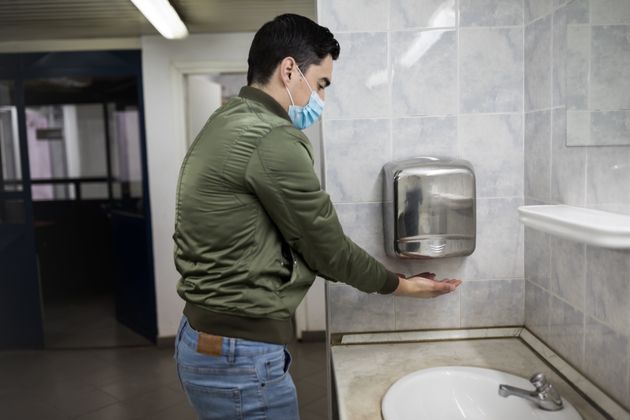The coronavirus pandemic has forced us to reevaluate a lot about our hygiene habits ― including how we dry our hands in public.
Experts we spoke to recently said drying your hands is almost as important as washing them, and the method you use has an impact.
Are paper towels preferable in a public toilet ― or are hand-dryers the way to go? Although some experts still debate this topic, more often than not, they say paper towel is king.
“I’d say the best way to dry your hands is with a paper towel that you discard afterwards,” said Sandra Kesh, a deputy medical director and infectious disease specialist at Westmed Medical Group in Westchester, New York.
Kesh explained that the goal of washing and drying is to remove as many viral particles as you can while also avoiding passing those germs on to any environmental surfaces nearby.
Hand dryers blow moisture off your hands ― some high-speed models can feel more like a gale-force wind ― but it’s also possible the dryer will launch moisture with viral particles into the air.
“With paper towels, you are capturing the viral particles in a confined location and removing them from the physical environment and then discarding them safely, in a garbage receptacle,” Kesh said.
Research also suggests that paper towels are best; one recent study showed that surfaces touched by people who had jet-dried were more likely to be contaminated than those touched by people who had used paper towels.

That’s not the only benefit to using paper towels in a public bathroom: You can also use a paper towel to safely grab the germy door handle and avoid coming into contact with the germs yourself, said Paul Pottinger, a professor of infectious diseases at the University of Washington School of Medicine.
“Otherwise, you might be immediately re-contaminating your hand when trying to get out of the lavatory,” he said.
Of course, from an ecological perspective, hand drying is generally a sounder choice. The experts we spoke to noted that it’s important to weigh the environmental impact of our paper towel use.
“We need to be conscious of paper towels and waste management,” said Jagdish Khubchandani, an associate chair and professor of health science at Ball State University.
Khubchandani added that we need to make sure to dispose of paper towels properly so sanitation workers won’t be exposed to germs. (Remember all those single-use gloves people were leaving out in the streets at the beginning of the pandemic?)
“I appreciate all the research coming out, but this world needs a more holistic view of disease prevention than isolated tips and strategies where we only protect ourselves,” he said. “We saw the case with gloves and masks; people are protected, but what about those who pick them from the streets [or bathrooms]?”
And while hand-drying is an essential part of hygiene practice, a good, thorough soap lathering is ultimately the most vital step, Pottinger said.
“Washing properly is the most important thing we can do to protect ourselves from accidentally contaminating ourselves when we touch our face,” he said.
A good, diligent scrub means you’re washing with soap and water for at least 20 seconds ― humming “Happy Birthday” from start to finish usually does the trick, Pottinger said ― and focusing on the entire hand, including the backs of the hands, between the fingers, the fingertips, and especially the thumbs.
“When you look at washing versus drying, the way that we dry our hands is much less important, but there is still a better way and a less good way,” he said.


